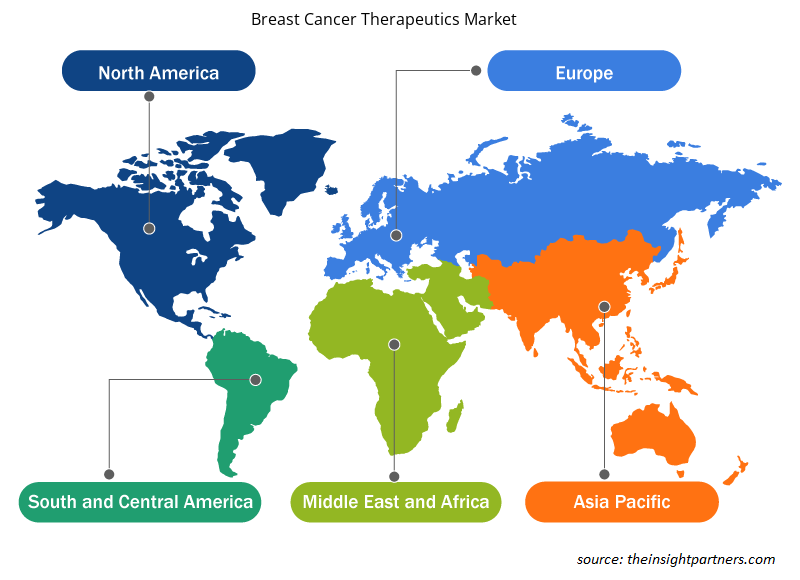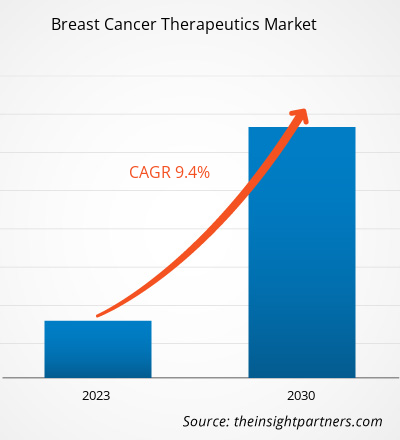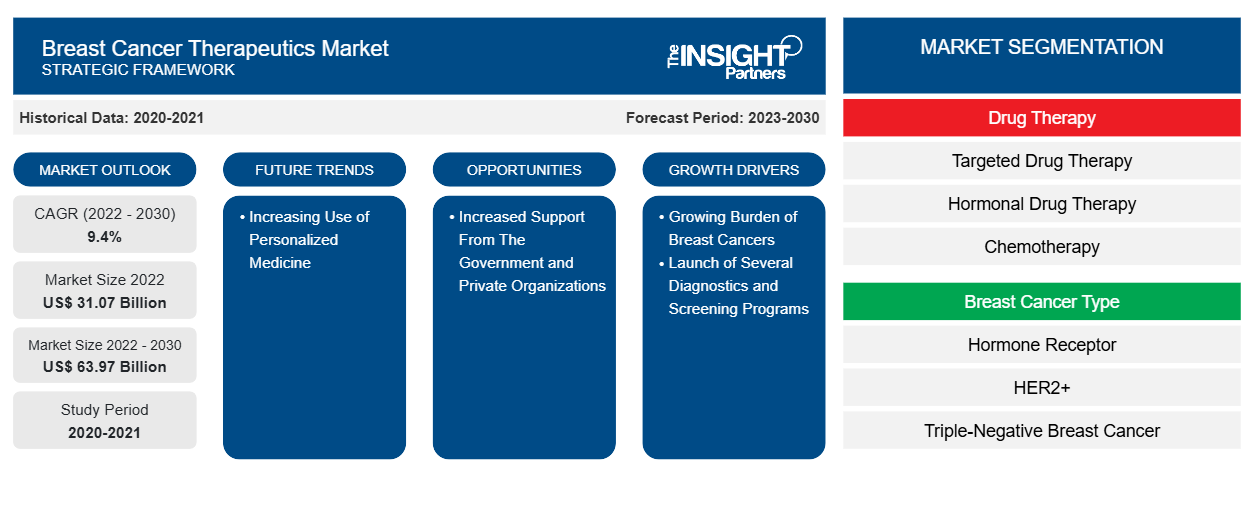[研究报告] 乳腺癌治疗市场规模预计将从 2022 年的 310.7352 亿美元增长到 2030 年的 639.6705 亿美元;预计 2022-2030 年期间的复合年增长率为 9.4%。
市场洞察和分析师观点:
乳腺癌治疗是一种通过使用化疗、靶向治疗、激素治疗、手术和各种药物等治疗方法来治疗乳腺癌的方法。这些疗法有助于限制乳腺癌细胞的生长和繁殖。全球乳腺癌患者的数量是加速市场增长的关键因素。此外,知名公司不断在全球范围内推出新药,推动了市场的增长。此外,不断增长的乳腺癌治疗药物渠道正在加剧竞争,并推动乳腺癌治疗市场的投资
增长动力:
个性化医疗、免疫疗法、联合疗法、药物输送系统、液体活检、人工智能和以患者为中心的方法的进步有望塑造乳腺癌治疗的未来。这些趋势旨在改善治疗效果、减少副作用并提高乳腺癌患者的整体生活质量。
早期疾病检测在改善患者治疗效果和存活率方面发挥着重要作用。各种组织和医疗保健提供者正在实施筛查计划,以便在乳腺癌早期阶段发现,因为那时乳腺癌更容易治疗。世界卫生组织于 2013 年 2 月发布了新的全球乳腺癌行动框架,旨在实现到 2040 年拯救 250 万人免于乳腺癌的目标。为了实现这一目标,在世界癌症日活动前夕公布的新框架敦促各国遵循健康促进的三大支柱,即早期发现、及时诊断和彻底治疗乳腺癌。这些计划通常包括乳房 X 线照相检查、临床乳房检查和自我乳房检查,以识别任何异常或乳腺癌迹象。实施这些计划提高了人们对乳腺癌病例的认识和早期发现,从而增加了对有效治疗方法的需求。
此外,全球范围内的诊断技术也取得了许多进步。美国国家医学图书馆指出,早期发现和准确诊断对于改善预后至关重要。乳腺癌评估经常使用放射成像方式,例如数字乳房X光检查 (DM)、数字乳房断层合成 (DBT)、磁共振成像(MRI)、超声和核医学程序。组织病理学 (HP) 是确定癌症存在的黄金标准。此外,使用人工智能 (AI) 技术定量描绘医学图像具有改善乳腺癌细分、诊断和预后的巨大潜力。这些技术可帮助医疗保健提供者确定肿瘤的范围和特征,从而使他们能够制定个性化的治疗计划。因此,诊断和筛查计划的推出,加上诊断技术的进步,促进了乳腺癌治疗市场的增长。
定制此报告以满足您的需求
您可以免费定制任何报告,包括本报告的部分内容、国家级分析、Excel 数据包,以及为初创企业和大学提供优惠和折扣
- 获取此报告的关键市场趋势。这个免费样品将包括数据分析,从市场趋势到估计和预测。
报告细分和范围:
“乳腺癌治疗市场”根据药物治疗、乳腺癌类型、分销渠道和地理位置进行细分。根据药物治疗,市场细分为靶向药物治疗、激素药物治疗、化疗和免疫治疗/生物治疗。就乳腺癌类型而言,乳腺癌治疗市场细分为激素受体、HER2+ 和三阴性乳腺癌。根据分销渠道,市场分为医院药房、药店和零售药店以及在线药店。根据地理分布,乳腺癌治疗市场分为北美(美国、加拿大和墨西哥)、欧洲(德国、法国、意大利、英国、西班牙和欧洲其他地区)、亚太地区(澳大利亚、中国、日本、印度、韩国和亚太其他地区)、中东和非洲(南非、沙特阿拉伯、阿联酋和中东和非洲其他地区)以及南美洲和中美洲(巴西、阿根廷和南美洲和中美洲其他地区)。
节段分析:
乳腺癌治疗市场按药物治疗细分为靶向药物治疗、激素药物治疗、化疗和免疫治疗/生物治疗。靶向药物治疗部分在 2022 年占据了最大的市场份额,预计在 2022-2030 年期间将实现市场最高复合年增长率。靶向药物通过破坏癌细胞或减缓其生长来阻止乳腺癌细胞的生长。目前,靶向治疗通常与传统化疗结合使用。靶向治疗有助于阻断促进乳腺癌细胞生长的异常蛋白质(如 HER2)的作用。靶向治疗分为 abemaciclib、ado-trastuzumab emtansine、Palbociclib、曲妥珠单抗等。曲妥珠单抗 (Herceptin) 或拉帕替尼 (TYKERB) 可以开给实验室检查显示乳腺肿瘤含有过量 HER2 的女性。 Kadcyla、Afinitor/Afinitor Disperz/Zortress 和 Lynparza 是一些关键的靶向治疗产品。2023 年 8 月,美国食品药品监督管理局 (FDA) 批准了曲妥珠单抗德鲁替康 (Enhertu),用于治疗 HER2 基因发生某种突变的非小细胞肺癌成人患者。它被认为是 HER2 突变型肺癌的首个靶向疗法。
靶向治疗在发达国家和新兴国家中已显著受到乳腺癌治疗的青睐。随着新产品的推出和大量药物的供应,靶向治疗领域预计将在乳腺癌治疗市场中占据相当大的份额。
根据乳腺癌类型,乳腺癌治疗市场细分为激素受体、HER2+ 和三阴性乳腺癌。激素受体部分在 2022 年占据了最大的市场份额,预计在 2022-2030 年期间将以最快的速度增长。雌激素和孕激素促进几种乳腺癌的生长,这些乳腺癌被称为激素敏感性或激素依赖性乳腺癌。激素受体是乳腺癌细胞表面的蛋白质,它们与体内的激素相互作用,并在激素与它们结合时被激活。激活的受体会引发特定基因表达的变化,从而刺激细胞生长。激素疗法是激素受体阳性乳腺癌的常见治疗方法,包括 SERM 和芳香酶抑制剂,占所有发病病例的很大一部分。由于每年诊断出的乳腺癌病例数量不断增加,激素受体部分可能会经历增长。
根据分销渠道,乳腺癌治疗市场细分为医院药房、药店和零售药房以及在线药房。医院药房部分在 2022 年占据了最大的市场份额。预计在线药房部分将在 2022-2030 年期间实现最高复合年增长率。医院药房在乳腺癌治疗管理中起着至关重要的作用。他们负责配药和配药、监测药物安全、药物管理、患者教育等。乳腺癌是全球最常见的癌症之一,对有效治疗方法的需求正在稳步增长。医院药房负责采购、储存和配药化疗药物和其他与乳腺癌相关的治疗,以确保患者及时得到正确的治疗。这些药房还有权管理这些药物的库存和储存,确保按照严格的规定进行储存和处理。他们与肿瘤学家和医疗团队的合作确保乳腺癌患者在整个治疗过程中获得最佳、个性化的治疗和全面的护理。医院药房在提供及时有效的乳腺癌治疗方面仍然发挥着重要作用,对患者对抗疾病的结果产生了重大影响。CAGR during 2022–2030. The hospital pharmacy plays a crucial role in the management of breast cancer therapeutics. They are responsible for compounding and dispensing, monitoring drug safety,
患者对这些药房的化疗药物和治疗管理的高度依赖、患者对各种治疗的需求不断增长以及医院药房药物供应的增强有利于该行业的发展。
区域分析:
根据地理位置,乳腺癌治疗市场分为五个主要区域:北美、欧洲、亚太地区、南美和中美以及中东和非洲。2022 年,北美占据了全球市场的很大份额。该地区的市场增长归因于乳腺癌患病率的上升和开发新疗法的研发投资的增加。此外,越来越多的市场参与者正在扩大其在北美国家的地理足迹。乳腺癌是最常见的癌症类型之一,治疗市场规模庞大。根据美国疾病控制和预防中心的数据,2020 年,美国女性报告了 239,612 例乳腺癌新病例,其中约 42,273 例死亡。每 100,000 名女性中,报告了 119 例女性乳腺癌新病例,其中近 19 例死亡。此外,根据加拿大癌症协会的数据,2022年约有28,600名加拿大女性被诊断出患有乳腺癌,占女性所有新癌症病例的25%左右。
化疗、免疫疗法、靶向疗法和激素疗法是可用的几种治疗选择。激素疗法旨在阻止支持特定形式乳腺癌生长的激素,而化疗则使用药物来摧毁癌细胞。免疫疗法利用人体的免疫系统对抗癌细胞,而靶向疗法则集中于与癌症生长有关的特定化学物质。对有效疗法的需求部分是由于该国乳腺癌的高发病率。
此外,医疗技术和研究的进步引发了突破性治疗方法的产生,这些治疗方法可以改善患者的治疗效果。辉瑞、诺华、罗氏、阿斯利康和礼来等几家大型制药公司主导着美国乳腺癌治疗市场。这些企业在研发方面投入了大量资金,将新型和增强型药物推向市场。政府制定的法规和政策也会影响市场。用于治疗乳腺癌的新药物和疗法由美国食品药品监督管理局 (FDA) 的政府机构批准。因此,在未来几年,乳腺癌治疗市场预计将进一步扩大。
乳腺癌治疗市场区域洞察
Insight Partners 的分析师已详尽解释了预测期内影响乳腺癌治疗市场的区域趋势和因素。本节还讨论了北美、欧洲、亚太地区、中东和非洲以及南美和中美洲的乳腺癌治疗市场细分和地理位置。

- 获取乳腺癌治疗市场的区域特定数据
乳腺癌治疗市场报告范围
| 报告属性 | 细节 |
|---|---|
| 2022 年市场规模 | 310.7亿美元 |
| 2030 年市场规模 | 639.7亿美元 |
| 全球复合年增长率(2022 - 2030 年) | 9.4% |
| 史料 | 2020-2021 |
| 预测期 | 2023-2030 |
| 涵盖的领域 | 通过药物治疗
|
| 覆盖地区和国家 | 北美
|
| 市场领导者和主要公司简介 |
|
市场参与者密度:了解其对商业动态的影响
乳腺癌治疗市场正在快速增长,这得益于终端用户需求的不断增长,而这些需求又源于消费者偏好的不断变化、技术进步以及对产品优势的认识不断提高等因素。随着需求的增加,企业正在扩大其产品范围,进行创新以满足消费者的需求,并利用新兴趋势,从而进一步推动市场增长。
市场参与者密度是指在特定市场或行业内运营的企业或公司的分布情况。它表明相对于给定市场空间的规模或总市场价值,有多少竞争对手(市场参与者)存在于该市场空间中。
在乳腺癌治疗市场运营的主要公司有:
- 礼来公司
- 卫材株式会社
- 诺华公司
- 阿斯利康公司
- 辉瑞公司
免责声明:上面列出的公司没有按照任何特定顺序排列。

- 了解乳腺癌治疗市场顶级关键参与者概况
行业发展和未来机遇:
以下列出了全球乳腺癌治疗市场主要参与者采取的各种举措:
- 2023年2月,吉利德科学公司获得美国食品药品监督管理局(FDA)批准Trodelvy(sacituzumab govitecan-hziy),用于治疗已接受过内分泌治疗和至少两种转移性全身治疗的不可切除的局部晚期或转移性激素受体(HR)阳性、人类表皮生长因子受体2(HER2)阴性乳腺癌成年患者。
- 2022年11月,礼来公司在获得印度药品管理总局 (DCGI) 批准后,推出了雷米文 (abemaciclib) 的附加适应症,联合内分泌疗法用于激素受体 (HR) 阳性、HER2 阴性、淋巴结阳性 EBC 且复发风险较高的成年患者的辅助治疗。
- 2020 年 1 月,卫材株式会社在中国推出了自主研发的抗癌药物 Halaven。在中国,Halaven 获得了新药批准,用于治疗之前至少接受过两种化疗方案治疗的局部晚期或转移性乳腺癌患者。
竞争格局和重点公司:
礼来公司、卫材公司、诺华公司、阿斯利康公司、辉瑞公司、吉利德科学公司、默克公司、基因泰克公司、梯瓦制药工业有限公司和安进公司是主要的乳腺癌治疗公司。这些公司专注于新技术、现有产品的改进和地域扩张,以满足全球日益增长的消费者需求。
- 历史分析(2 年)、基准年、预测(7 年)及复合年增长率
- PEST和SWOT分析
- 市场规模、价值/数量 - 全球、区域、国家
- 行业和竞争格局
- Excel 数据集
近期报告
相关报告
客户评价
购买理由
- 明智的决策
- 了解市场动态
- 竞争分析
- 客户洞察
- 市场预测
- 风险规避
- 战略规划
- 投资论证
- 识别新兴市场
- 优化营销策略
- 提升运营效率
- 顺应监管趋势





















 获取免费样品 - 乳腺癌治疗市场
获取免费样品 - 乳腺癌治疗市场